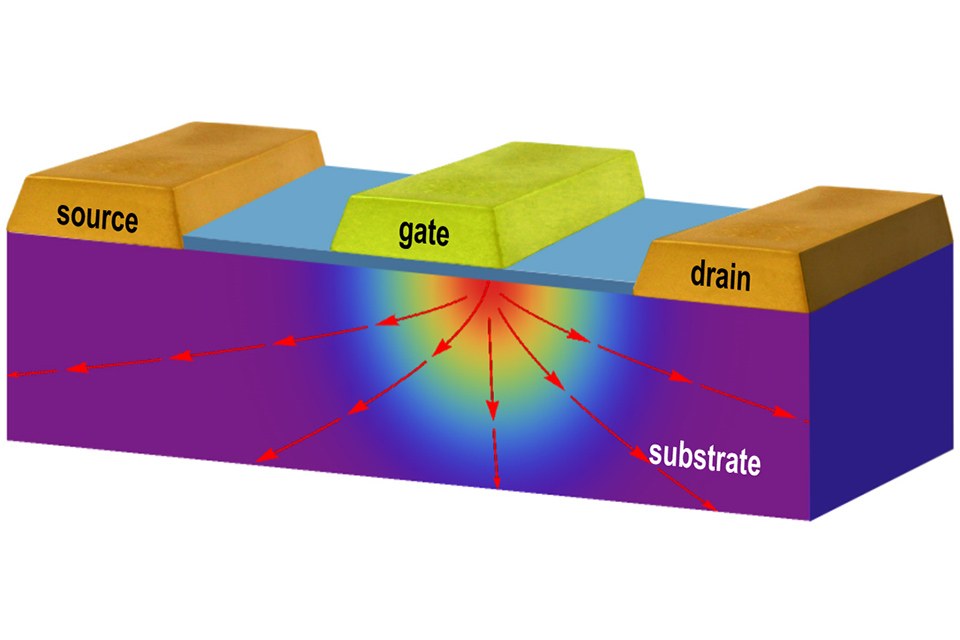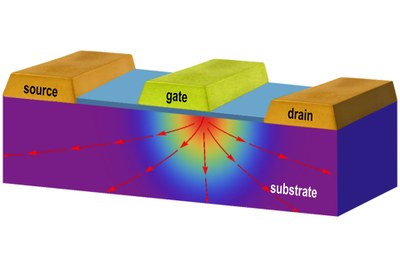NRL Researchers Discover Novel Material for Cooling of Electronic Devices
A team of theoretical physicists at the U.S. Naval Research Laboratory (NRL) and Boston College has identified cubic boron arsenide as a material with an extraordinarily high thermal conductivity and the potential to transfer heat more effectively from electronic devices than diamond, the best-known thermal conductor to date.
As microelectronic devices become smaller, faster, and more powerful, thermal management is becoming a critical challenge. This work provides new insight into the nature of thermal transport at a quantitative level and predicts a new material, with ultra-high thermal conductivity, of potential interest for passive cooling applications.
Calculating the thermal conductivity of cubic III-V boron compounds using a predictive first principles approach, the team has found boron arsenide (BAs) to have a remarkable room temperature thermal conductivity, greater than 2,000 Watts per meter per degree Kelvin (>2000 Wm-1K-1). This is comparable to those in diamond and graphite, which are the highest bulk values known.
Unlike metals, where the electrons carry the heat, diamond and boron arsenide are electrical insulators. For the latter type of materials heat is carried by vibrational waves (phonons) of the constituent atoms, and intrinsic resistance to heat flow results from these waves scattering from one another. Diamond is of interest for cooling applications but it is scarce and its synthetic fabrication suffers from slow growth rates, high costs, and low quality. However, little progress has been made to date in identifying new high thermally conductive materials.
Historically, fully microscopic, parameter-free computational materials techniques have been more advanced for electronic properties than for thermal transport.
"In the last few years with contributions from the NRL team, 'ab initio' quantitative techniques have been developed for thermal transport," said Dr. Thomas L. Reinecke, physicist, Electronics Science and Technology Division. "These techniques open the way to a fuller understanding of the key physical features in thermal transport and to the ability to predict accurately the thermal conductivity of new materials."
These surprising findings for boron arsenide result from an unusual interplay of certain of its vibrational properties that lie outside of the guidelines commonly used to estimate the thermal conductivity of electrical insulators. These features cause scatterings between vibrational waves to be far less likely than is typical in a certain range of frequencies, which in turn allows large amounts heat to be conducted in this frequency range.
"If these exciting results are verified by experiment, it will open new opportunities for passive cooling applications with boron arsenide, and it would demonstrate the important role that such theoretical work can play in providing guidance to identify new high thermal conductivity materials," Reinecke says.
Thermal conductivity calculations from this group are in good agreement with available experimental results for a wide range of materials. The team consisted of Drs. Lucas Lindsay and Tom Reinecke at NRL and Dr. David Broido at Boston College.
This research, supported in part by the Office of Naval Research (ONR) and the Defense Advanced Research Projects Agency (DARPA), gives important new insight into the physics of thermal transport in materials, and it illustrates the power of modern computational techniques in making quantitative predictions for materials whose properties have yet to be measured.
About the U.S. Naval Research Laboratory:
The U.S. Naval Research Laboratory is the Navy's full-spectrum corporate laboratory, conducting a broadly based multidisciplinary program of scientific research and advanced technological development. The Laboratory, with a total complement of nearly 2,500 personnel, is located in southwest Washington, D.C., with other major sites at the Stennis Space Center, Miss., and Monterey, Calif. NRL has served the Navy and the nation for over 85 years and continues to meet the complex technological challenges of today's world. For more information, visit the NRL homepage
See original press release at http://www.nrl.navy.mil/media/news-releases/2013/nrl-researchers-discover-novel-material-for-cooling-of-electronic-devices


